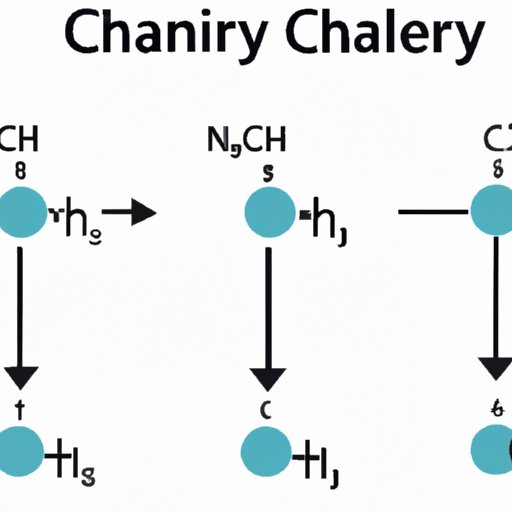Introduction
When studying chemistry, formal charge is an important concept to understand. Formal charge is the electrical charge on an atom in a molecule, assuming that electrons are shared equally between atoms. It helps predict reactivity and stability, and is essential in understanding the behavior of different molecules. This article will provide a beginner’s guide to how to calculate formal charge in molecules, as well as an in-depth exploration of its importance in chemistry.
A Beginner’s Guide to Calculating Formal Charges in Molecules
Formal charge is different from actual charge, which is the real charge that an atom has. Actual charge can be positive, negative or neutral, but formal charge is calculated assuming that all the electrons in a bond are shared equally between the atoms involved.
The formula to calculate formal charge is as follows:
Formal charge = Valence electrons – (non-bonding electrons + 1/2 bonding electrons)
Valence electrons are the outermost electrons that are available for bonding in an atom. Non-bonding electrons are the lone pairs of electrons that exist on an atom. Bonding electrons are half of the total electrons in the bond between two atoms.
For example, let’s consider the formal charge of the oxygen atom in a water molecule. The valence electrons of oxygen are 6, there are 4 non-bonding electrons on the oxygen atom, and 4 bonding electrons between the oxygen and the two hydrogen atoms (2 electrons shared with each hydrogen atom).
Using the above formula, formal charge of the oxygen atom in water molecule is:
6- (4+ 1/2 x 4) = 6-6 = 0
In this case, the oxygen atom has a formal charge of 0.
Mastering Formal Charge Calculation: Tips and Tricks
While the above formula can be applied to any molecule to calculate the formal charge, there are some tips and tricks that can make the calculation process easier and more accurate.
One important tip to keep in mind is that the sum of formal charges in a molecule should always be equal to the actual charge of the molecule. If the sum of formal charges does not add up to the actual charge, then something has been calculated incorrectly.
Another common mistake is to improperly assign electrons to atoms. Electrons should be assigned to the atom where they are physically located in the molecule, rather than being assigned to the atom with the highest electronegativity.
A helpful trick for calculating formal charge in molecules with multiple atoms is to assign electrons to their most electronegative atom. This helps to minimize formal charges across the molecule, leading to a more stable compound.
The Importance of Formal Charge Calculation in Chemistry
Formal charge plays an important role in predicting reactivity, stability, and chemical properties of molecules. It can be used to determine the most stable resonance form of a molecule, as well as to predict which atom in a molecule is more likely to be involved in a reaction.
For example, in a molecule with multiple resonance forms, the most stable form will have the lowest formal charges. Similarly, in a reaction involving a molecule with multiple atoms, the atom with the highest formal charge is more likely to undergo a reaction.
Formal charge is also an important concept in biochemistry, as it can be used to predict the behavior of different chemicals in biological systems.
Step by Step: How to Calculate Formal Charges in Covalent Molecules
Calculating formal charge in covalent molecules is a straightforward process that can be done step-by-step.
1. Determine the valence electrons for each atom in the molecule.
2. Count the non-bonding electrons on each atom.
3. Count the number of electrons shared in each bond, and divide by 2.
4. Use the formula to calculate the formal charge of each atom.
As the complexity of the molecule increases, the calculations can become more tedious. However, with practice, calculating formal charge becomes easier and quicker.
Understanding Formal Charge in Ionic Molecules
While the concept of formal charge applies mainly to covalent molecules, it can also be used in some cases for ionic molecules. In ionic molecules, formal charge is calculated using the same formula as for covalent molecules, but with some differences.
For example, in an ionic compound, the formal charge of an atom is equal to its oxidation state, which is the number of valence electrons it has gained or lost. This differs from the calculation of formal charge in covalent compounds, where oxidation state is not considered.
Common Mistakes to Avoid When Calculating Formal Charge in Molecules
As mentioned earlier, there are some common mistakes that should be avoided when calculating formal charge. These mistakes include improperly assigning electrons to atoms and failing to properly account for electron sharing in bonds.
Another common mistake is to assume that formal charge is the same as actual charge, which can result in miscalculations.
To avoid these mistakes, it is important to follow the step-by-step process carefully, double-check calculations, and to practice with different types of molecules.
Conclusion
In conclusion, calculating formal charge is an essential part of understanding the behavior of different molecules. It helps predict reactivity, stability, and chemical properties, and can be used to determine the most stable resonance form of a molecule. With practice, anyone can master the technique of calculating formal charge and use it to succeed in chemistry.
